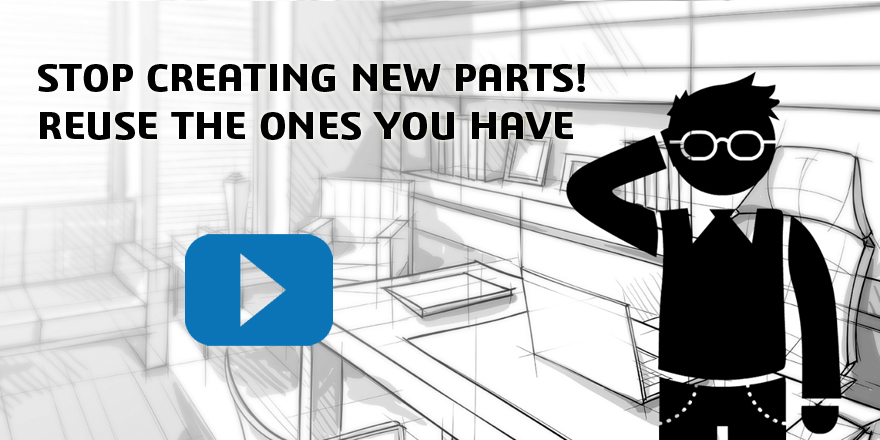According to industry analysts the Aberdeen Group, the annual carrying costs of introducing a new part number range between $4,500 and $23,000 per item. When a designer or engineer decides to create a new part instead of searching to see whether it already exists, significant expenses can be incurred. In product development alone, new part designs have to be analyzed, validated, and prototyped, steps that can consume valuable R&D resources and delay time-to-market. Moreover, by making something new, instead of utilizing tried-and-tested designs, new part development can increase the risk of problems related to quality and manufacturability.
Carrying over existing parts
Carrying over existing parts, instead of creating new, is not a new challenge. Most companies have put in place a system for doing so. But do companies realize the value of reusing even small, high-volume standard parts? Not reusing these parts can be astoundingly costly. By leveraging existing designs, every aspect of a manufacturing enterprise and extended supply chain—including product design, engineering, documentation, procurement, purchasing, manufacturing, inventory, distribution, service, sales, marketing, and management—will become more efficient, improving quality while accelerating time-to-market, which can lead to more satisfied and loyal customers.
But what’s the best way to reuse? What’s really needed is a tool like EXALEAD OnePart that finds not only the CAD file, but gathers all existing part-related information no matter the format—adding similarity, metadata, and semantic-linked documents and related information to shape search capabilities—through an integrated search experience that mirrors the manner in which popular Internet search engines and user-friendly e-commerce applications operate. It allows users throughout the organization, whether savvy with CAD technology or not, to quickly discover if the part exists by simply shortlisting the possible designs, comparing them, checking their similarity, navigating parent/child relationships, and assembling related documents to revitalize the product development enterprise.
How does OnePart contribute to the engineering, manufacturing, and procurement functions?
OnePart helps design engineers achieve goals such as:
Identifying master parts for wider reuse and standardization purposes.
- Tagging master parts is critical for design reuse, eliminating duplicates, and helping procurement drive volume pricing with suppliers.
- Finding parts based on key status criteria: work in progress, quarantine, obsolete, duplicate, etc.) strengthens global coordination and knowledge sharing to lower release risks and reduce costs.
Focusing more capacity on design innovation and less on recreating redundant parts.
- Fast and efficient access to the company’s accumulated legacy IP accelerates part reuse and capitalizes on the past to inspire future designs.
- Connecting a part’s 3D shape with all associated metadata and related documentation can drive innovation and make better reuse decisions possible.

Manufacturing directors can achieve the following goals:
One solution to capture and reuse latent data and knowledge located in various systems spread around the enterprise would be extremely useful for:
- Gaining early visibility into engineering data on current parts.
- Accurately identifying and reusing substitute parts for production based on the 3D model, related data, and associated documentation.
- Locating and reusing similar process plans, routing sheets, and associated tooling/fixture information quickly and efficiently.
- To help bring newly designed parts into production faster, while identifying ways to simplify manufacturing and assembly of parts.
And procurement professionals can:
Be empowered to drive the part purchasing strategy by:
- Ensuring procurement’s influence in part selection and final decision process
- Simplifying identification of best parts and best suppliers across the company
- Leveling the playing field with suppliers:
Enhance performance with:
- Deeper build-vs.-buy analysis based on comparing all enterprise data
- Economy of scale volume buying – based on selection/standardization of a master part rather than similar or duplicate parts
- Dynamic cost estimates – based on aggregated learning from past purchases from any data source
- Efficient aggregation and comparison of data for proposed and qualified BOM components
- Reuse maximization through part comparison transparency – avoiding expensive one-off supplier charges on unique parts, tooling, fixtures, or materials
Influence quality, time-to-market, and standardization objectives by:
- Decreasing dependency on Engineering–ensure all CAD content and related data are readily available and presented in suitable context for Procurement
- Lowering dependency on IT–all engineering, parts, costs, and supply chain data are available in one application
- Integrating supplier quality (warranty/recall data) into the selection process
- Incorporating supply chain, transportation, and logistics data into the process
- Automating classification of parts into libraries–eliminating duplicates and driving higher standardization rates
EXALEAD OnePart Benefits
- Increase reuse to speed program completion and part standardization
- Avoid costs associated with duplicate part creation and release risk
- Free up engineering capacity to drive new innovation
- Achieve production objectives on time and on budget
- Empower procurement to drive lower prices from suppliers
- Increase quality and reduce time-to-market
- Contribute to the company’s financial performance and margin goals
EXALEAD OnePart is integrated into the Dassault Systèmes Bid to Win solution experience for automotive suppliers. Based on the 3DEXPERIENCE platform, Bid to Win helps suppliers win new opportunities, unify multi-site projects, and ensure profitability.

